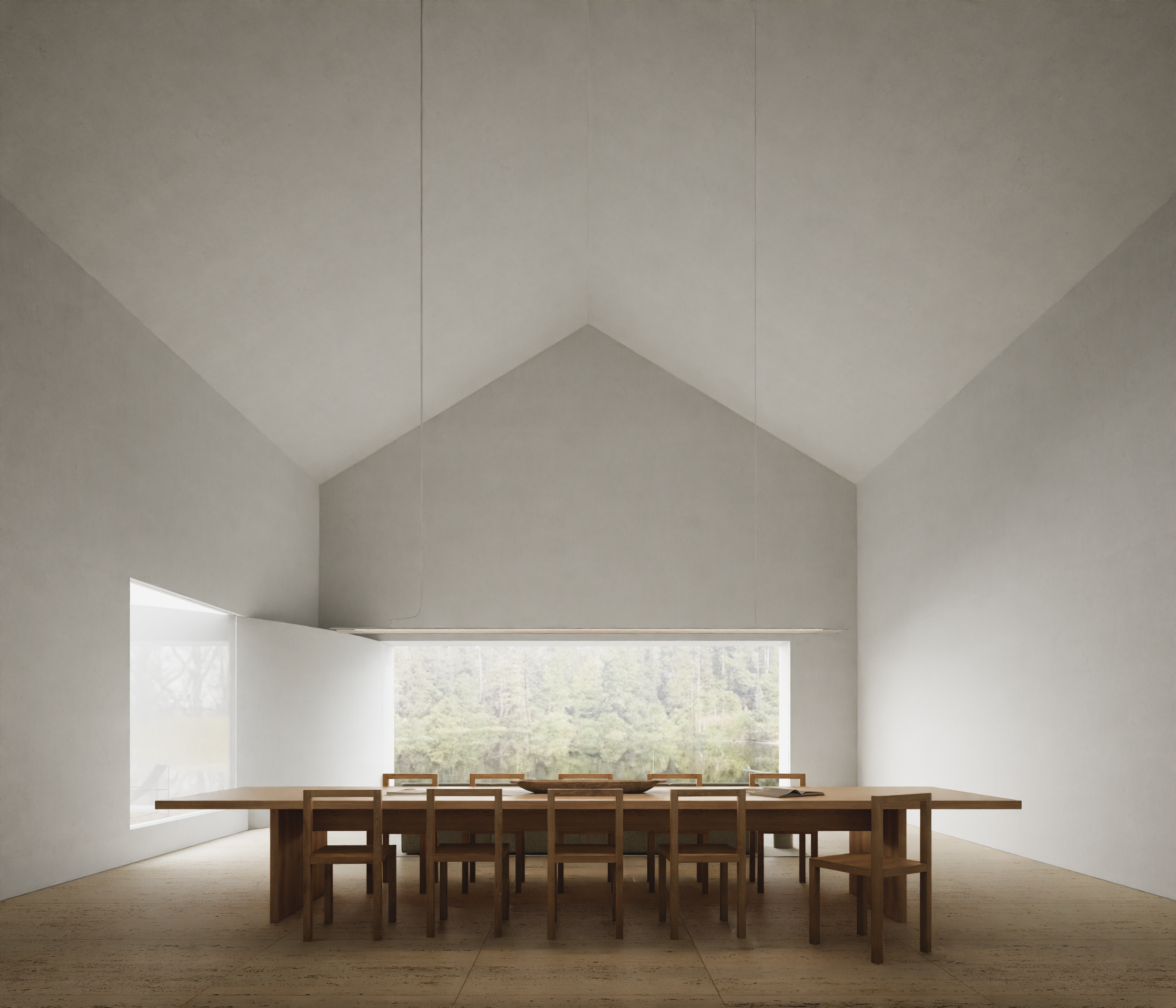
CASA FRENTE AL LAGO . HOUSE IN FRONT OF THE LAKE . 湖前的房子
El uso del arquetipo de la casa en la arquitectura es para mí un acto de rebeldía contra la tradición moderna. Durante mucho tiempo, la arquitectura modernista se centró en la abstracción, la racionalidad y la búsqueda de la novedad a toda costa. Sin embargo, en este trabajo, he buscado un enfoque diferente, uno que se base en la comprensión profunda del lugar y la conexión emocional con la arquitectura.
La casa, como arquetipo, es algo profundamente arraigado en nuestra cultura y memoria colectiva. Es un símbolo de refugio, seguridad y pertenencia. Pero en lugar de simplemente repetir formas tradicionales, la utilizamos como punto de partida para explorar nuevas posibilidades. Nos preguntamos: ¿cómo puede una casa reinterpretar su relación con el entorno? ¿Cómo puede desafiar las convenciones preestablecidas y ofrecer una experiencia espacial única?
Nuestras casas no son simples réplicas de estructuras tradicionales; son una respuesta a un lugar y a las necesidades contemporáneas. Buscamos la simplicidad en las formas y la paleta de materiales, pero al mismo tiempo, aspiramos a la sofisticación en la experiencia. La luz se convierte en una herramienta para esculpir el espacio, y cada detalle se cuida minuciosamente para crear un ambiente que inspire calma y reflexión.
En lugar de ver la tradición como una camisa de fuerza, la utilizamos como una fuente de inspiración y como una plataforma para la innovación. El arquetipo de la casa se convierte en un medio para desafiar la rigidez de la arquitectura moderna y crear un lenguaje arquitectónico que sea sensible al contexto y a las emociones humanas.
En última instancia, considero que el uso del arquetipo de la casa en la arquitectura es un acto de revuelta contra la uniformidad y la impersonalidad de la tradición moderna.
Es un recordatorio de que la arquitectura debe ser más que un ejercicio intelectual; debe ser una expresión de nuestra relación con el mundo que nos rodea y un reflejo de nuestra identidad cultural. Es a través de esta rebeldía que buscamos reinventar la arquitectura y encontrar una nueva forma de belleza en la simplicidad y la conexión con la tierra.
-
Lakefront House.
The use of the house archetype in architecture is, to me, an act of rebellion against modern tradition. For a long time, modernist architecture focused on abstraction, rationality, and the pursuit of novelty at all costs. However, in this work, I have sought a different approach, one based on a deep understanding of the place and an emotional connection with architecture.
The house, as an archetype, is deeply rooted in our culture and collective memory. It is a symbol of refuge, security, and belonging. But instead of simply repeating traditional forms, we use it as a starting point to explore new possibilities. We ask ourselves: how can a house reinterpret its relationship with the environment? How can it challenge pre-established conventions and offer a unique spatial experience?
Our houses are not simple replicas of traditional structures; they are a response to a place and contemporary needs. We seek simplicity in forms and material palette, but at the same time, we aspire to sophistication in the experience. Light becomes a tool to sculpt space, and every detail is meticulously cared for to create an atmosphere that inspires calm and reflection.
Instead of seeing tradition as a straitjacket, we use it as a source of inspiration and as a platform for innovation. The house archetype becomes a means to challenge the rigidity of modern architecture and create an architectural language that is sensitive to context and human emotions.
Ultimately, I consider the use of the house archetype in architecture as an act of rebellion against the uniformity and impersonality of modern tradition.
It is a reminder that architecture must be more than an intellectual exercise; it must be an expression of our relationship with the world around us and a reflection of our cultural identity. It is through this rebellion that we seek to reinvent architecture and find a new form of beauty in simplicity and connection to the land.
-
湖畔住宅。
在建筑中使用房屋原型对我来说是一种对现代传统的反叛行为。长期以来,现代主义建筑专注于抽象、理性和不惜一切追求新颖。然而,在这项工作中,我寻求了一种不同的方法,这种方法基于对地点的深刻理解和对建筑的情感联系。
房屋作为原型,在我们的文化和集体记忆中根深蒂固。它是庇护、安全和归属的象征。但我们并不简单地重复传统形式,而是将其作为探索新可能性的起点。我们问自己:一栋房子如何重新诠释与环境的关系?它如何挑战既定的传统,并提供独特的空间体验?
我们的房子不是传统结构的简单复制;它们是对地点和当代需求的回应。我们追求形式和材料调色板上的简约,但同时,我们也渴望在体验上追求复杂。光线成为塑造空间的工具,每一个细节都被精心打理,以营造一个激发平静和反思的氛围。
我们并不将传统视为一种紧箍咒,而是将其视为一种灵感来源和创新平台。房屋原型成为挑战现代建筑僵化性的手段,并创造出一种对环境和人类情感敏感的建筑语言。
最终,我认为在建筑中使用房屋原型是一种对现代传统单一性和非个性化的反叛行为。
这是一个提醒,建筑必须超越知识性练习;它必须是我们与周围世界的关系和我们文化身份的反映。通过这种反叛,我们寻求重新发明建筑,并在简单和与大地的联系中找到一种新的美的形式。























